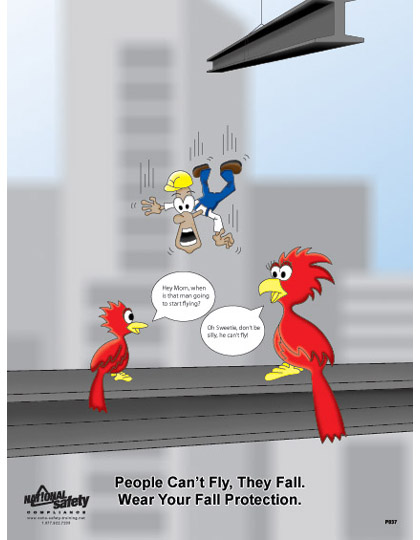It seems that the Top Ten List of Violations on OSHA’s Top Ten for 2009, were still on their Top Ten List for 2010, many of them just in different places. The third highest on the penalties assessed list for 2010 was violation of (29CFR 1910.21), Safety Training and Education, Construction, Walking and Working Surfaces. Serious, willful, or repeat violations can result in harm or death from hazards, and it seems that employers would do everything in their power to protect their employees from such hazards, rather than pay stiff penalties.
Slips, trips, and falls constitute the majority of general industry accidents; fifteen per cent of all accidental deaths are caused by slips, trips, or falls – second only to motor vehicles as a cause of fatalities. OSHA standards for walking/working surfaces apply to all permanent places of employment, except where only domestic, mining, or agricultural work is performed. Annually, about 20 workplace fatalities happen, with another 3,700 injuries resulting in lost workdays.
As in any job, on-the-job training is first and foremost, with the accent on safety. Employees who could be exposed to specific hazards related to walking and working surfaces, scaffolding, mobile elevated work platforms, and portable and fixed ladders, should have full knowledge of the safeguards and precautions to prevent injuries. Retraining is imperative for affected employees whenever there is a change in the appropriate area, or when an employee is seen deviating from the prescribed safe work practices. Training should be done by experienced and qualified persons. Training should be certified with written training records, and actual work observations should verify the effectiveness of such training.
- Proper guarding should be provided for open pits, ditches, floor openings, and other open areas by covering or guarding with a standard railing. If not guarded or covered, it must be protected by a temporary barrier on all exposed sides or attended by an assigned person.
- Appropriate railings for stairways that are 30” – 34” to tread should be provided.
- A standard railing on all open sides should guard all open-sided platforms that measure four feet or more above the adjacent floor of ground level.
- Six foot controlled access zones along pits, floors, and flat roof edges where fall protection is not feasible should be set up. A controlled access zone must use control lines or other barriers to restrict employee access to fall hazards. Warning signs must be posted at controlled access zones.
- Employees working on steep slope roofs (greater than four inches of run per twelve inches of rise) that are four feet or more above a lower level must be protected from falls by a guard rail system, personal fall arrest system, or safety net system; and
- Employees working on low slope roofs (less than or equal to four inches of run per twelve inches of rise) with unprotected sides and edges that are four feet or more above a lower level are protected by one of the following methods:
(1) A guard railing system; (2) personal fall arrest system; (3) safety net system; (4) combination of a “warning line” and any other of the above; or (5) a combination of a “warning line” and a safety monitor.
Walking and working surfaces should have the strength and integrity to support employees safely. Floors should not be overloaded with materials and/or equipment over the approved load limits. Elevated storage and other platforms should be marked with the load bearing weight. Aisles and passageways should be clearly visible and allow space for both moving equipment and employees. There should also be safe clearance room at all turns, doors, and passageways, and the areas should not be obstructed by physical barriers or stored materials. Work environments should be kept neat and orderly, waste properly discarded, and floors kept clean. Mats and grating could be used when appropriate.
Hopefully, this year will bring fewer violations of this standard, as well as many others. Training employees, protecting them from workplace injuries by better planning and housekeeping, and giving them the right PPE for each particular job will pay dividends for companies, along with the reward of a safe workday every day for each person. That would be the best reward for everyone involved!
